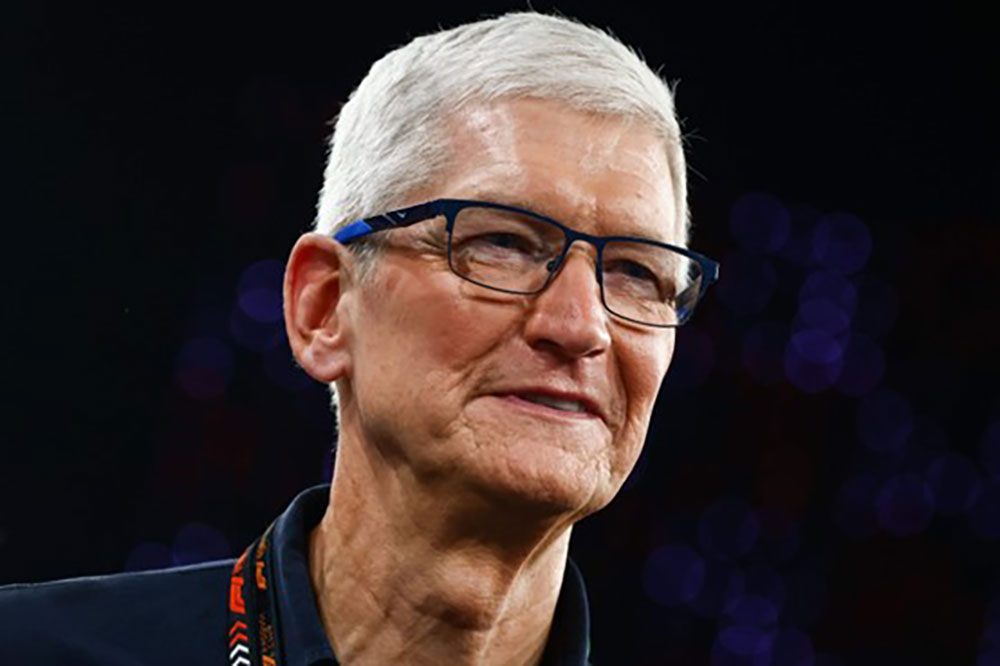
蘋果公司周二展示了其最新科幻愿景,,宣布其產(chǎn)品用戶未來或能通過腦信號操控設(shè)備。借助腦植入技術(shù),,倘若這一設(shè)想得以實現(xiàn),,這將標志著該公司又一重大里程碑。
這項計劃旨在為殘障人士提供幫助(至少目前如此),,這表明蘋果公司仍關(guān)注前沿創(chuàng)新,。但這也凸顯了該公司面臨的挑戰(zhàn):其大部分創(chuàng)新成果短期內(nèi)既無法面向普通大眾,也難以成為暢銷產(chǎn)品,。
華爾街認為,,蘋果公司當下亟需的是更為基礎(chǔ)性的增長:大幅提升核心產(chǎn)品iPhone的銷量。近三年來,,iPhone營收基本停滯,,給這家科技巨頭的股價造成了壓力。
受增長放緩及對唐納德·特朗普總統(tǒng)貿(mào)易戰(zhàn)潛在沖擊的擔憂,,蘋果公司股價今年已下跌15%,。
蘋果公司首席執(zhí)行官蒂姆·庫克正迫切尋求破局之策,試圖扭轉(zhuǎn)公司困境,,但相關(guān)舉措至今成效寥寥,。
為最新款iPhone搭載人工智能以提振銷量的計劃收效甚微。該公司在開發(fā)許多極具吸引力的人工智能功能配套軟件時出現(xiàn)了異常失誤,,無奈之下,,不得不將這些功能的發(fā)布日期推遲到今年晚些時候。
在本月早些時候與分析師的電話會議上,,庫克強調(diào)了iPhone與人工智能(即蘋果公司品牌體系下的“蘋果智能”)相融合的積極一面,。他表示,在最新季度iPhone 16系列(最新款)的銷售數(shù)據(jù)中,,搭載“蘋果智能”功能的國家市場銷量高于未搭載該功能的國家市場,。不過,蘋果公司目前在為iPhone引入前沿人工智能功能時,,仍依賴OpenAI等合作伙伴,,而iPhone的營收約占蘋果公司總營收的一半,。
去年,蘋果公司推出了Vision Pro增強現(xiàn)實頭顯,,本可成為其業(yè)務(wù)增長的新引擎,。使用這款設(shè)備的用戶能夠在現(xiàn)實場景中投射電影,或者仿佛置身于NBA賽場前排觀賽,。許多評論者對其創(chuàng)新設(shè)計贊譽有加,,相較競品,它能讓用戶看到周圍的人,。然而,,這款頭顯最終未能吸引廣大消費者,因為它外觀看起來很怪異,,就像人們滑雪時佩戴的裝備,,而且售價高達3500美元。
蘋果公司其他雄心勃勃的項目情況更糟,,比如其耗時十年,、斥資數(shù)十億美元的自動駕駛汽車技術(shù)研發(fā)項目。蘋果公司在2024年終止了該項目,。
蘋果公司周二宣布,,其設(shè)備未來或?qū)⑦m配患有肌萎縮側(cè)索硬化癥(ALS)或脊髓損傷等疾病的人群,這是另一項極具創(chuàng)新性的舉措,。通過該項目,,蘋果公司希望與專注開發(fā)所謂腦機接口(即腦植入物)以識別腦信號的公司合作。蘋果公司已與其中一家名為Synchron的公司合作,,共同制定相關(guān)標準,,使患者無需任何肢體動作便能操控蘋果設(shè)備。
Synchron公司首席執(zhí)行官兼聯(lián)合創(chuàng)始人湯姆·奧克斯利(Tom Oxley)博士在一份聲明中表示:“這標志著人機交互領(lǐng)域的決定性時刻,。腦機接口不僅僅是輔助殘障人士的工具,,還是下一代的交互界面。蘋果公司正助力開創(chuàng)全新的交互模式,,在這種模式下,,腦信號與觸控、語音和鍵盤輸入一樣,,得到正式認可,。”
不過,,當前植入腦機接口的患者數(shù)量相對有限,尚不清楚患者何時能夠借助這一新標準操作蘋果設(shè)備,。
腦植入物領(lǐng)域最知名的公司是由埃隆·馬斯克創(chuàng)立的Neuralink,。該公司首位受試者已能夠借助植入物移動光標,。
盡管馬斯克曾將腦機接口技術(shù)描繪成普適性能力增強工具,但蘋果公司在周二的聲明中則相對低調(diào),。該公司僅提及植入物及其相關(guān)計劃旨在幫助殘障人士操作其設(shè)備,,并未提及該項目未來將廣泛用于商業(yè)用途。
目前,,蘋果公司iPhone銷量增長乏力問題仍有待解決,。(財富中文網(wǎng))
譯者:中慧言-王芳
蘋果公司周二展示了其最新科幻愿景,宣布其產(chǎn)品用戶未來或能通過腦信號操控設(shè)備,。借助腦植入技術(shù),,倘若這一設(shè)想得以實現(xiàn),這將標志著該公司又一重大里程碑,。
這項計劃旨在為殘障人士提供幫助(至少目前如此),,這表明蘋果公司仍關(guān)注前沿創(chuàng)新。但這也凸顯了該公司面臨的挑戰(zhàn):其大部分創(chuàng)新成果短期內(nèi)既無法面向普通大眾,,也難以成為暢銷產(chǎn)品,。
華爾街認為,蘋果公司當下亟需的是更為基礎(chǔ)性的增長:大幅提升核心產(chǎn)品iPhone的銷量,。近三年來,,iPhone營收基本停滯,給這家科技巨頭的股價造成了壓力,。
受增長放緩及對唐納德·特朗普總統(tǒng)貿(mào)易戰(zhàn)潛在沖擊的擔憂,,蘋果公司股價今年已下跌15%。
蘋果公司首席執(zhí)行官蒂姆·庫克正迫切尋求破局之策,,試圖扭轉(zhuǎn)公司困境,,但相關(guān)舉措至今成效寥寥。
為最新款iPhone搭載人工智能以提振銷量的計劃收效甚微,。該公司在開發(fā)許多極具吸引力的人工智能功能配套軟件時出現(xiàn)了異常失誤,,無奈之下,不得不將這些功能的發(fā)布日期推遲到今年晚些時候,。
在本月早些時候與分析師的電話會議上,,庫克強調(diào)了iPhone與人工智能(即蘋果公司品牌體系下的“蘋果智能”)相融合的積極一面。他表示,,在最新季度iPhone 16系列(最新款)的銷售數(shù)據(jù)中,,搭載“蘋果智能”功能的國家市場銷量高于未搭載該功能的國家市場。不過,,蘋果公司目前在為iPhone引入前沿人工智能功能時,,仍依賴OpenAI等合作伙伴,而iPhone的營收約占蘋果公司總營收的一半。
去年,,蘋果公司推出了Vision Pro增強現(xiàn)實頭顯,,本可成為其業(yè)務(wù)增長的新引擎。使用這款設(shè)備的用戶能夠在現(xiàn)實場景中投射電影,,或者仿佛置身于NBA賽場前排觀賽,。許多評論者對其創(chuàng)新設(shè)計贊譽有加,相較競品,,它能讓用戶看到周圍的人,。然而,這款頭顯最終未能吸引廣大消費者,,因為它外觀看起來很怪異,,就像人們滑雪時佩戴的裝備,而且售價高達3500美元,。
蘋果公司其他雄心勃勃的項目情況更糟,,比如其耗時十年、斥資數(shù)十億美元的自動駕駛汽車技術(shù)研發(fā)項目,。蘋果公司在2024年終止了該項目,。
蘋果公司周二宣布,其設(shè)備未來或?qū)⑦m配患有肌萎縮側(cè)索硬化癥(ALS)或脊髓損傷等疾病的人群,,這是另一項極具創(chuàng)新性的舉措,。通過該項目,蘋果公司希望與專注開發(fā)所謂腦機接口(即腦植入物)以識別腦信號的公司合作,。蘋果公司已與其中一家名為Synchron的公司合作,,共同制定相關(guān)標準,使患者無需任何肢體動作便能操控蘋果設(shè)備,。
Synchron公司首席執(zhí)行官兼聯(lián)合創(chuàng)始人湯姆·奧克斯利(Tom Oxley)博士在一份聲明中表示:“這標志著人機交互領(lǐng)域的決定性時刻,。腦機接口不僅僅是輔助殘障人士的工具,還是下一代的交互界面,。蘋果公司正助力開創(chuàng)全新的交互模式,,在這種模式下,腦信號與觸控,、語音和鍵盤輸入一樣,,得到正式認可?!?/p>
不過,,當前植入腦機接口的患者數(shù)量相對有限,尚不清楚患者何時能夠借助這一新標準操作蘋果設(shè)備,。
腦植入物領(lǐng)域最知名的公司是由埃隆·馬斯克創(chuàng)立的Neuralink,。該公司首位受試者已能夠借助植入物移動光標,。
盡管馬斯克曾將腦機接口技術(shù)描繪成普適性能力增強工具,但蘋果公司在周二的聲明中則相對低調(diào),。該公司僅提及植入物及其相關(guān)計劃旨在幫助殘障人士操作其設(shè)備,,并未提及該項目未來將廣泛用于商業(yè)用途,。
目前,,蘋果公司iPhone銷量增長乏力問題仍有待解決。(財富中文網(wǎng))
譯者:中慧言-王芳
Apple showcased its latest sci-fi vision on Tuesday by announcing that users of its products may one day be able to control them with brain signals. If achieved, with the help of brain implants, it would mark another huge milestone for the company.
The initiative, aimed at helping only disabled users, at least for now, shows that Apple still has its eye on cutting-edge innovation. But it also highlights the company’s challenge: Much of that innovation isn’t destined for the general public or ready to be a big seller any time soon.
What Apple really needs, according to Wall Street, is something far more mundane: Growth in sales of its all-important iPhone. Nearly three years of largely stagnant revenue from the device is weighing on the tech giant’s shares.
Apple’s stock is down 15% this year, due to a combination of slow growth and the feared impact of President Donald Trump’s trade war.
Apple CEO Tim Cook is racing to come up with a fix for his company’s predicament. But those efforts have been far from successful.
A plan to jumpstart iPhone sales by infusing the latest model with artificial intelligence has failed to have much impact. The company uncharacteristically fumbled on developing the promised software behind many of the most appealing AI features and, in a major embarrassment, had to delay their release until sometime later this year.
In a call with analysts earlier this month, Cook stressed the positive when it comes to the iPhone and artificial intelligence —or Apple Intelligence, under the company’s branding. He said sales during of the latest quarter of the most recent iPhone family, iPhone 16, was higher in countries where Apple Intelligence was offered than in countries where it wasn’t. Still, Apple is currently dependent on partners like OpenAI for bringing the most advanced AI features to the iPhone, which accounts for roughly half of Apple’s revenue.
Last year, Apple had another chance to lift its business when it started selling its Vision Pro augmented reality goggles. The device lets people wearing it seemingly project a movie onto the real world or make them seem like they’re watching an NBA game from the front row. Many reviewers praised Apple’s innovative design, which included letting users see people around them, unlike some goggles from rival companies. But ultimately, the device hasn’t appealed to a broad public because it looks awkward—like something you’d see people wearing on a ski slope—and costs a pricey $3,500.
Other ambitious efforts, like its decade-long, multi-billion dollar project to develop self-driving car technology, fared even worse. Apple pulled the plug on that project in 2024.
Apple’s announcement on Tuesday about making its devices potentially compatible for people who have a disease like ALS or spinal cord injuries is another highly innovative effort. With the project, Apple hopes to partner with companies working on so-called brain computer interfaces, or brain implants, that can understand brain signals. Apple has worked with one of those companies, Synchron, to develop a standard that would let patients control Apple devices without any physical movement.
“This marks a defining moment for human-device interaction. BCI is more than an accessibility tool, it’s a next-generation interface layer,” Dr. Tom Oxley, Synchron’s CEO and cofounder, said in a statement. “Apple is helping to pioneer a new interface paradigm, where brain signals are formally recognized alongside touch, voice and typing.”
For now, only a relative handful of patients have brain computer implants. It’s unclear when any patients will be able to use Apple devices through the new standard.
The most prominent company in the brain implant field is Neuralink, founded by Elon Musk. Its first patient was able to show he could move a cursor with the help of an implant.
Although Musk has pitched brain computer interfaces as something all people could use to amplify their abilities, Apple was more muted on Tuesday. In its statement, it mentioned implants and its initiative only in terms of helping disabled people use its devices, and made no mention of its project ever leading to wide commercial use.
For now, Apple’s iPhone sales growth problem is still waiting to be solved.






